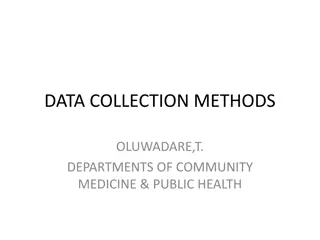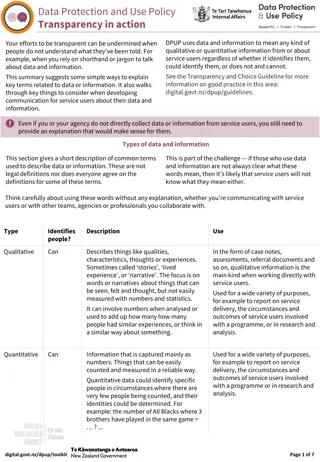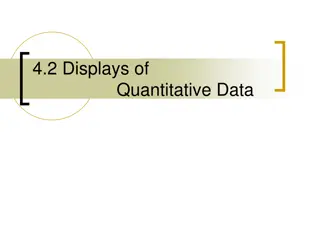Understanding Dotplots for Displaying Quantitative Data
Learn how to create and interpret dotplots for quantitative data visualization. This lesson covers making dotplots, describing distribution shapes, and comparing data sets. Explore the simplicity and effectiveness of dotplots in representing numerical information. Gain insights into analyzing dotplots to identify peaks, clusters, gaps, symmetry, and skewness in distributions.
Download Presentation

Please find below an Image/Link to download the presentation.
The content on the website is provided AS IS for your information and personal use only. It may not be sold, licensed, or shared on other websites without obtaining consent from the author. Download presentation by click this link. If you encounter any issues during the download, it is possible that the publisher has removed the file from their server.
E N D
Presentation Transcript
Analyzing One-Variable Data Lesson 1.3 Displaying Quantitative Data: Dotplots Statistics and Probability with Applications, 3rdEdition Starnes, Tabor Bedford Freeman Worth Publishers
Displaying Quantitative Data: Dotplots Learning Targets After this lesson, you should be able to: Make and interpret dotplots of quantitative data. Describe the shape of a distribution. Compare distributions of quantitative data with dotplots. Statistics and Probability with Applications, 3rd Edition 2 2
Displaying Quantitative Data: Dotplots You can use a bar chart or pie chart to display categorical data. A dotplot is the simplest graph for displaying quantitative data. Dotplot A dotplot shows each data value as a dot above its location on a number line. Statistics and Probability with Applications, 3rd Edition 3 3
Displaying Quantitative Data: Dotplots How to Make a Dotplot 1. Draw and label the axis. Draw a horizontal axis and put the name of the quantitative variable underneath. 2. Scale the axis. Look at the smallest and largest values in the data set. Start the horizontal axis at a number equal to or below the smallest value and place tick marks at equal intervals until you equal or exceed the largest value. 3. Plot the values. Mark a dot above the location on the horizontal axis corresponding to each data value. Try to make all the dots the same size and space them out equally as you stack them. Statistics and Probability with Applications, 3rd Edition 4 4
How much would you pay for fun? How much would you pay for fun? Making a dotplot Making a dotplot PROBLEM: Knoebels Amusement Park in Elysburg, Pennsylvania, has earned acclaim for being an affordable, family-friendly entertainment venue. Knoebels does not charge for general admission or parking, but they do charge customers for each ride they take. How much do the rides cost at Knoebels? The table below shows the cost for each ride in a sample of 22 rides in a recent year. Make a dotplot of these data. SOLUTION: Cost Name Cost Merry Mixer $1.50 Looper $1.75 Italian Trapeze $1.50 Flying Turns $3.00 Satellite $1.50 Flyer $1.50 Galleon $1.50 The Haunted Mansion $1.75 Whipper $1.25 StratosFear $2.00 Skooters $1.75 Twister $2.50 Ribbit $1.25 Cosmotron $1.75 Roundup $1.50 Paratrooper $1.50 Paradrop $1.25 Downdraft $1.50 The Phoenix $2.50 Rockin' Tug $1.25 Gasoline Alley $1.75 Sklooosh! $1.75 Name Statistics and Probability with Applications, 3rd Edition 5 5
Displaying Quantitative Data: Dotplots When you describe the shape of a dotplot or other graph of quantitative data, focus on the main features. Look for major peaks, not for minor ups and downs in the graph. Look for clusters of values and obvious gaps. Look for rough symmetry or clear skewness. A distribution is roughly symmetric if the right and left sides of the graph are approximately mirror images of each other. A distribution is skewed to the right if the right side of the graph is much longer than the left side. It is skewed to the left if the left side of the graph is much longer than the right side. Roughly Symmetric Skewed-left Skewed-right Statistics and Probability with Applications, 3rd Edition 6 6
How long will you have to wait to get your quiz score? How long will you have to wait to get your quiz score? Describing shape Describing shape PROBLEM: The dotplots below display two different sets of quantitative data. Graph (a) shows the number of minutes 100 passengers waited to catch the Riverfront Streetcar in New Orleans and graph (b) shows the scores of 21 statistics students on a 20-point quiz. (a) SOLUTION: (a) The dotplot of wait times is roughly symmetric and has no clear peak. It has about the same height for all values from 1 to10. Statistics and Probability with Applications, 3rd Edition 7 7
How long will you have to wait to get your quiz score? How long will you have to wait to get your quiz score? Describing shape Describing shape PROBLEM: The dotplots below display two different sets of quantitative data. Graph (a) shows the number of minutes 100 passengers waited to catch the Riverfront Streetcar in New Orleans and graph (b) shows the scores of 21 statistics students on a 20-point quiz. (b) SOLUTION: (b) The distribution of quiz scores has a peak at 20 points and is left- skewed. Most students did very well, scoring 17 points or higher. Four students scored 15 points or less, with one student scoring very low (11 points) compared to most of the class. Statistics and Probability with Applications, 3rd Edition 8 8
Displaying Quantitative Data: Dotplots In any graph, look for the overall pattern and for clear departures from that pattern. How to Describe the Distribution of a Quantitative Variable You can describe the overall pattern of a distribution by its shape, center, and variability (spread). An important kind of departure is an outlier, a value that falls outside the overall pattern. Think SOCS(shape, outliers, center, spread) when describing the distribution of a quantitative variable When comparing distributions of quantitative data, it s not enough just to list values for the center and spread of each distribution. You have to explicitly comparethese values, using words like greater than, less than, or about the same as. Statistics and Probability with Applications, 3rd Edition 9 9
Who screams for ice cream? Who screams for ice cream? Comparing distributions with dotplots Comparing distributions with dotplots PROBLEM: As a student project, Jonathan and Crystal held an ice- cream-eating contest. Each participant was given a small novelty cup of ice cream and instructed to eat it as fast as possible. Jonathan and Crystal then recorded each contestant s gender and time (in seconds), as shown in the dotplot. Compare the distributions of eating times for males and females. Statistics and Probability with Applications, 3rd Edition 10 10
Who screams for ice cream? Who screams for ice cream? Comparing distributions with dotplots Comparing distributions with dotplots SOLUTION: Shape: The graphs of both the female times and male times are slightly skewed to the right. Outliers: The males had a cluster of 3 times that seem somewhat long at about 47-50 seconds, while the females had a cluster of 3 times that seem short at about 12-13 seconds and one time that seems extremely long at around 107 seconds. Center: The male times tend to be faster (centered around 20 seconds) than the female times (centered around 45 seconds). Spread (Variability): The times for females varied more (13 107 seconds) than the times for males (7 50 seconds). Statistics and Probability with Applications, 3rd Edition 11 11
LESSON APP 1.3 Nitrates are organic compounds that are a main ingredient in fertilizers. When those fertilizers run into streams, the nitrates can have a toxic effect on fish. An ecologist studying nitrate pollution in two streams measures nitrate concentrations at 42 places on Stony Brook and 42 places on Mill Brook. The parallel dotplots display the data. How can we check the health of a stream? 1. Explain what the dot above 12 in the Stony Brook graph represents. 2. What percent of the nitrate concentration measurements for each stream exceeded 10 milligrams per liter (mg/l)? 3. Compare the centers of these two distributions. 4. Is the variability in nitrate concentrations for the two streams similar or different? Justify your answer. Statistics and Probability with Applications, 3rd Edition 12 12
LESSON APP 1.3 How can we check the health of a stream? Statistics and Probability with Applications, 3rd Edition 13 13
Displaying Quantitative Data: Dotplots Learning Targets After this lesson, you should be able to: Make and interpret dotplots of quantitative data. Describe the shape of a distribution. Compare distributions of quantitative data with dotplots. Statistics and Probability with Applications, 3rd Edition 14 14























